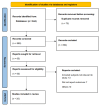Efficacy and Safety of Direct Oral Anticoagulants Versus Vitamin K Antagonists for Left Ventricular Thrombus: A Systematic Review and Meta-Analysis
- PMID: 40585598
- PMCID: PMC12203140
- DOI: 10.7759/cureus.84941
Efficacy and Safety of Direct Oral Anticoagulants Versus Vitamin K Antagonists for Left Ventricular Thrombus: A Systematic Review and Meta-Analysis
Abstract
Left ventricular thrombus (LVT) is a serious complication associated with myocardial infarction and cardiomyopathy. While vitamin K antagonists (VKAs) have been the standard treatment, direct oral anticoagulants (DOACs) offer potential advantages. This meta-analysis compares the efficacy and safety of DOACs versus VKAs in patients with LVT. We conducted a systematic search of PubMed, Excerpta Medica database (Embase), Scopus, Web of Science, and Cochrane Central Register of Controlled Trials (CENTRAL) from inception to April 2025. Studies comparing DOACs with VKAs in adult patients with LVT were included. The primary outcome was LVT resolution; secondary outcomes included stroke or systemic embolism (SSE) and bleeding events. Random-effects models were used to calculate pooled risk ratios (RRs) with 95% confidence intervals. Thirty-five studies (five RCTs and 30 observational) with 4,823 patients were included. LVT resolution was comparable between DOACs and VKAs (RR: 1.04, 95% CI: 0.99-1.10, I² = 30%). Risk of SSE showed no significant difference (RR: 0.91, 95% CI: 0.80-1.03, I² = 11%). DOACs were associated with significantly lower bleeding risk (RR: 0.87, 95% CI: 0.81-0.94, I² = 0%). Subgroup analyses by study design showed consistent findings. DOACs demonstrated comparable efficacy to VKAs for LVT resolution and stroke prevention while offering a superior safety profile with lower bleeding risk. These findings suggest DOACs may be a viable alternative to VKAs in LVT management, though large-scale randomized trials are needed to confirm these results and establish optimal dosing strategies.
Keywords: anticoagulation therapy; direct oral anticoagulants; left ventricular thrombus; thromboembolism; vitamin k antagonists.
Copyright © 2025, Khan et al.
Conflict of interest statement
Conflicts of interest: In compliance with the ICMJE uniform disclosure form, all authors declare the following: Payment/services info: All authors have declared that no financial support was received from any organization for the submitted work. Financial relationships: All authors have declared that they have no financial relationships at present or within the previous three years with any organizations that might have an interest in the submitted work. Other relationships: All authors have declared that there are no other relationships or activities that could appear to have influenced the submitted work.
Figures




References
-
- Emerging trends in left ventricular thrombus: a comprehensive review of non-ischemic and ischemic cardiopathies, including eosinophilic myocarditis, Chagas cardiomyopathy, amyloidosis, and innovative anticoagulant approaches. Colle B, Demeure F, Higny J, et al. Diagnostics (Basel) 2024;14:948. - PMC - PubMed
-
- Advancing clinical management of left ventricular thrombosis: prevention, detection and treatment modalities in the modern era. Zhang Q, Zheng H, Zhang Z, Xu Y, Zhang W. Heart. 2025 - PubMed
-
- Management of patients at risk for and with left ventricular thrombus: a scientific statement from the American Heart Association. Levine GN, McEvoy JW, Fang JC, et al. Circulation. 2022;146:0–23. - PubMed
-
- Left ventricular thrombus therapy with direct oral anticoagulants versus vitamin K antagonists: a systematic review and meta-analysis. Saleiro C, Lopes J, De Campos D, Puga L, Costa M, Gonçalves L, Teixeira R. J Cardiovasc Pharmacol Ther. 2021;26:233–243. - PubMed
-
- Non-vitamin K antagonist oral anticoagulants: considerations on once- vs. twice-daily regimens and their potential impact on medication adherence. Vrijens B, Heidbuchel H. Europace. 2015;17:514–523. - PubMed
Publication types
LinkOut - more resources
Full Text Sources
Miscellaneous
